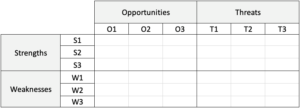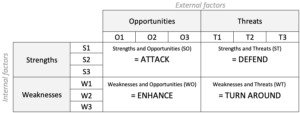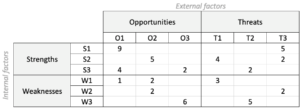A SWOT analysis is a simple yet powerful tool that can give you actionable insights into building on what you do well, addressing where you’re performing less well, minimising risks, and seizing opportunities for success. A confrontation matrix lets you take your SWOT analysis one step further.
This article explains how to turn your SWOT analysis into a confrontation matrix that weighs each strength and weakness against each opportunity and threat, and how you can use this information to clearly identify the best way forward.
You want to understand the Strengths, Weaknesses, Opportunities, and Threats related to any specific element of your plan, strategy, project, department or even your business model, so a SWOT is the obvious place to start.
While a well-performed SWOT, complete with a prioritised action plan can indeed provide valuable information about how best to proceed, a confrontation matrix looks at the links between strengths and weakness, and opportunities and threats, to help you develop the most appropriate strategies for our particular situation.
So how do you set up such a confrontation matrix? And how do you draw conclusions from the outcome and determine the actions to take?
Setting up a confrontation matrix
The prerequisite for a confrontation matrix is the outcome of your SWOT analysis, which ideally, resulted in 3-5 critical elements in each quadrant.
On your whiteboard/sheet of paper/spreadsheet, plot your strengths and weaknesses on the vertical axis, and your opportunities and threats on the horizontal axis as shown below.

Identifying strategic options
The resulting four quadrants each hold a clue to strategies you may choose:
- Strengths and Opportunities (SO): The combination of strengths and opportunities indicates that you are operating in an area you already perform well in, but where there are still opportunities to seize. If you ‘attack’ here, i.e. develop strategies that use your strengths to maximise opportunities, you can gain an advantage over your competitors.
- Strengths and Threats (ST): The combination of strengths and threats indicates that you need to take action to defend your market position. Here, you can identify strategies that use your strengths to minimise threats.
- Weaknesses and Opportunities (WO): This quadrant shows the areas where you are not performing strongly but where taking advantage of external opportunities could minimise those weaknesses.
- Weaknesses and Threats (WT): A combination of high weakness and high threat indicates that you are operating in an area you are not good at and where there are many external threats. Here, you can either identify strategies that minimise your weaknesses and avoid threats, or decide to ‘turn around’ and not pursue a certain line of action.

Achieving consensus on which strategies to pursue
Opinions about the importance of each of the SWOT results may differ between you and your colleagues, so having the various stakeholders score each one – from most important to less important – will give you the most balanced results.
To do this:
-
- Starting with opportunity 1 (O1), look at the different internal options (strengths and weaknesses). Each person in your group should assign a score of 3 to what they feel is the most important one, a score of 2 to the next best option, and a score of 1 to the next best option. All other options receive a score of 0.
- Continue working left to right across the matrix until you have completed the column for the final threat.
- The results of this should tell you where you team believes attention should be focused, and how urgently. For example, strengths with a high opportunity score can determine the strategic direction (e.g. O1-S1 in the table below), but weaknesses with a high opportunity score (e.g. O3-W3) can also be converted quickly into actions.

Conclusion
A confrontation matrix can help you objectively work through the various options generated from your SWOT analysis.
With differing opinions about how to proceed, this scoring method ensures that everyone’s voice is heard in a democratic way, and allows a collective decision to be taken.
It also reduces the risk of overlooking quick fixes where seizing an opportunity can minimise weaknesses.
For more about marketing and sales strategy, take a look at our marketing and sales strategy guide.


